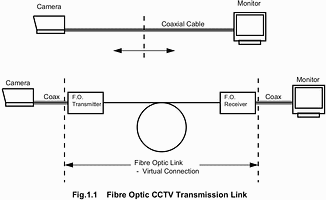
In the first article of this series we looked at the benefits of using fibre-optics in CCTV and related security applications (Hi-Tech Security Solutions March/April 2004, 'Fibre-optics in CCTV applications'). In this, the second of the articles focusing on fibre-optics, David Archer, technical manager, Fiber Options, examines the various components required to create a fibre-optic link, starting with the transmitter and ending with the receiver.
The function of a fibre-optic link is to provide an alternative means of communications to twisted pair wires or coaxial cables, and may simply be regarded as creating a 'virtual' connection between two existing electrical segments of 'conventional' copper cable, as shown in Figure 1. This is all that the link does. In the majority of cases, the better it is performing, the less the user will be aware of its presence.

In its simplest form the link is comprised of just three components:
* A fibre-optics transmitter, for converting the incoming electrical signal from the source (eg, camera) into a modulated beam of light.
* The optical fibre itself, for guiding this light to a receiver over distances which can vary from a few metres to many tens of kilometres.
* A fibre-optics receiver, for reconverting the much smaller level of received light back into an equivalent electrical signal, usually identical in form to that of the source signal.
Most fibre-optic links contain additional components, such as connectors and spliced joints, in order to assist the practicality of the design.
Fibre-optic transmitter
The most important component in the fibre-optic transmitter is the optical light source, which will be either a semiconductor laser or light emitting diode (LED). Both serve the same purpose, which is to generate a microscopic beam of light that can be efficiently coupled into the fibre and modulated (varied in intensity) at high speed. Lasers provide greater optical intensities than LEDs and can also be modulated at higher speeds; hence these are used extensively for long-haul high-bandwidth applications such as telecommunications and cable TV. LEDs, on the other hand, are lower cost and more robust devices, yet are more than adequate for the vast majority of short- to medium-range applications and hence are widely used within the CCTV industry.
Apart from its function (ie, what signals it is required to carry), there are two significant characteristics that define the properties of a fibre-optic transmitter, whether laser and LED-based. One of these is the optical output power or intensity and the other is the wavelength (or colour) of the emitted light. This will usually be either 850, 1310 or 1550 nm (nanometres), values which have been chosen to coincide with certain low loss 'windows' in the fibre transmission characteristic.
Fibre-optic receiver
The fibre-optic receiver is tasked with the vital job of detecting the very small level of optical radiation emerging from the end of the fibre, and then amplifying the resulting electrical signal to the required level with minimal distortion and added noise. The lowest level of light that the receiver requires to produce an acceptable performance is referred to as its sensitivity; the difference between this and the transmitter output defines the maximum system loss capability in dB. A figure between 10 and 15 dB is typical for many LED-based CCTV surveillance CCTV systems.
Ideally, the receiver should be able to cope with a wide range of optical signal levels, as it is usually not possible to predict in advance precisely what degree of attenuation will be present in the fibre-optic link (length of link, number of connectors, etc). Many simple receiver designs employ a manual gain control that has to be set by the installer to achieve the required output level. This is undesirable, as inevitably there will be changes in link attenuation, caused by ageing or temperature variations etc, which will dictate a need for routine gain adjustments at recurring intervals.
All Fiber Options' receivers feature automatic gain control (AGC) that monitors the average level of incoming optical signal, and adjusts the receiver gain accordingly. No manual adjustment is required, either during installation or throughout its working life.
For more information contact Elvey Security Technologies, 011 401 6700, [email protected], www.elvey.co.za
| Tel: | +27 11 401 6700 |
| Email: | [email protected] |
| www: | www.elvey.co.za |
| Articles: | More information and articles about Elvey Security Technologies |

© Technews Publishing (Pty) Ltd. | All Rights Reserved.